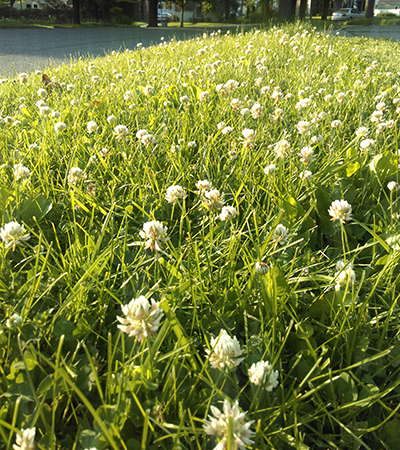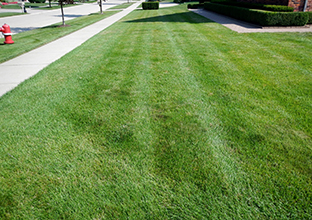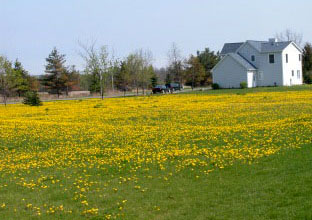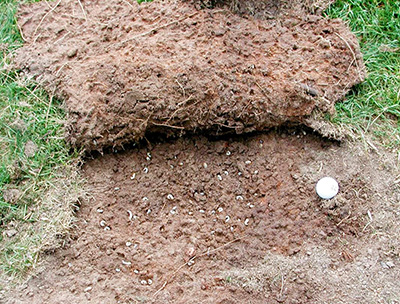
Smart lawn care to protect pollinators
DOWNLOADJanuary 25, 2017 - Dave Smitley
 Almost everyone would like to help protect honey bees, wild bees, butterflies and other pollinators that visit lawns and gardens. One of the best ways to support pollinators is by increasing the number and diversity of flowering plants in your yard. Turf by itself does not provide any food for bees because it does not flower. If you prefer a traditional lawn free of flowering weeds, you can bolster the resources for pollinators by planting flowering trees and shrubs and expanding your flowerbeds. Other gardeners may choose to allow a few flowers, like clover, in the turf. Whether you choose weed-free or a more relaxed approach to your lawn, Michigan State University Extension suggests the following practices that will keep it bee-friendly.
Almost everyone would like to help protect honey bees, wild bees, butterflies and other pollinators that visit lawns and gardens. One of the best ways to support pollinators is by increasing the number and diversity of flowering plants in your yard. Turf by itself does not provide any food for bees because it does not flower. If you prefer a traditional lawn free of flowering weeds, you can bolster the resources for pollinators by planting flowering trees and shrubs and expanding your flowerbeds. Other gardeners may choose to allow a few flowers, like clover, in the turf. Whether you choose weed-free or a more relaxed approach to your lawn, Michigan State University Extension suggests the following practices that will keep it bee-friendly.

A lawn that mixes white clover with grass. Photo: Rufus Isaacs, MSU.
The green, weed-free lawn
When caring for this type of lawn, herbicides and insecticides are typically used to eliminate weeds and pest insects. Pollinators, especially bees, are highly susceptible to these chemicals and you will need to take precautions to avoid exposing them. Any spray that lands on blooming weeds such as clover will ultimately end up in a bee’s diet. Either mow off the blooms from weeds before applying the pesticide or, if possible, make applications at an appropriate time when weeds are not blooming. In the case of grubs, the window for treatments is late May to mid-August.
Most insecticides used for grub control, like imidacloprid, are systemic insecticides that can be absorbed by tree roots. Since trace amounts of these insecticides could be moved from the tree roots into pollen and nectar, follow three simple practices to minimize any potential impact on pollinators.
First, make sure the dead patches are due to grubs before you apply an insecticide (see resources at the end of publication). Second, if there are flowering trees attractive to bees growing in the landscape where there is lawn, use chlorantraniliprole (Acelepryn or GrubEx) instead of imidacloprid or clothianidin. Finally, an alternative is simply to wait until after July 1 to apply the insecticide as nearly all trees found in Michigan yards bloom prior to July 1. If lawns are sprayed after that time, very little imidacloprid or clothianidin will be in the soil the following spring, either eliminating or minimizing harm to pollinators from grub control practices.
Do not spray your lawn when it is windy. Wind tends to die down early or late in the day, making it easier to contain pesticide applications from drifting onto flowerbeds or flowering shrubs.


Take steps to protect bees whether your lawn is weed-free or flowering. Photos: Kevin Frank, MSU.
Controlling grubs in lawns with flowering weeds
If you like to leave a few dandelions, clover or other flowering weeds in your lawn for pollinators, and you determine grubs are feeding on the turf, here are your options. Use chlorantraniliprole (Acelepryn or GrubEx), which is not harmful for pollinators. If you use imidacloprid, clothianidin or thiomethoxam, do not apply it when weeds are flowering because these insecticides will be absorbed into the nectar, and are lethal for bees. If weeds are blooming, use one of the products that does not harm bees, or mow the lawn short enough to remove all the flowers before spraying liquid or spreading granular grub control products.

Turfgrass peeled back to reveal grubs feeding on the roots. Photo: Kevin Frank, MSU.
Chinch bugs or sod webworms in any lawn
White grubs are the most important turf pest in Michigan. Although unusual, chinch bugs and sod webworms may damage your lawn, requiring an insecticide treatment. If you choose to apply an insecticide, spray only the infested spots after mowing to remove any flowers. Lawns watered daily during dry periods are almost never damaged by chinch bugs or sod webworms.
Managing healthy lawns without insecticides
You may be able to avoid using insecticides on your lawn and therefore protect pollinators. Based on MSU research, smart gardeners can follow these four practices to create a grub-tolerant lawn:
- Choose Kentucky bluegrass or fine fescue when establishing a new lawn (most established lawns already consist of these two grasses).
- Leave the grass longer by mowing your lawn at the highest setting on your lawn mower (greater than 3 inches).
- Use at least 2 pounds of nitrogen per 1,000 square feet each year.
- Water lawns frequently during dry spells.

Reduce weeds and insecticide use by mowing your lawn on the highest setting. Photo: Rebecca Finneran, MSU Extension.
With these three practices, a healthy root system develops that can resist grubs and other pest insects. The dense and deep roots create a thick layer that even a heavy grub infestation is not able to consume entirely. This dense layer of roots supports springtails and other tiny arthropods in the soil that predatory (beneficial) insects feed on. These predators feed on white grubs and help keep them under control.
Additional resources
- MSU Extension bulletin E3314: “How to protect and increase pollinators in your landscape” for information including lists of best trees, shrubs and flowers for attracting bees and butterflies.
- MSU Extension article: “How to choose and when to apply grub control products for your lawn” for information on how to identify if grubs are causing the damage.



 Print
Print Email
Email





